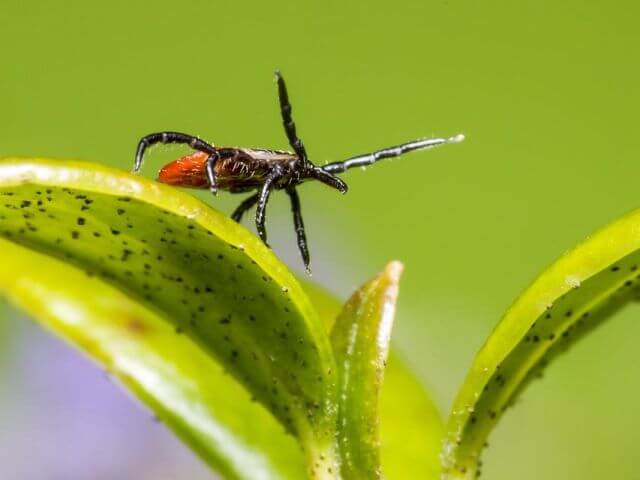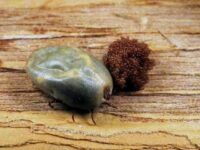When temperatures and humidity are high enough, then ticks become active. Ticks live all over the world in all climate zones except the Arctic. The times when ticks are most active depend on the geographic location of the tick. Ticks can only be active when the weather is warm enough and a certain temperature has been reached as they cannot generate own body heat.
When the temperature is too low for ticks to be active, they fall into a kind of dormant state, a stasis in which they slow down their metabolism and wait for the next warm period until the temperatures are high enough and they can become active again.
When Are Ticks Most Active?
Ticks are most active when the temperature is above 45 degrees Fahrenheit (7 Celsius).
In North America, northern Europe, and northern Asia, where there are seasons, ticks are usually only active in the frost-free months.
In the tropical and subtropical climate zones, where the temperatures are always higher than 45 degrees Fahrenheit (7 Celsius), ticks are active all year round.
When the temperature is high enough and the weather is warm and humid, ticks feel most comfortable. Then the small parasites crawl up on, blades of grass, flowers, or low branches, stretch their front legs (where their olfactory organs are), in the air, and lie in wait for a suitable host animal.
When is tick season?
- In the northern hemisphere, the height of tick season is from the months of April to October
- In the southern hemisphere, where the seasons are opposite to the northern seasons, the height of tick season is from October through April
- In the tropics, where it s always warm enough, it is tick season all year round.
| Ticks are most active during the warm months when temperatures and humidity are favorable for these nasty parasites. However, this does not mean that ticks are not active during the cooler seasons and that the risk of tick bites is negligible.
Whenever temperatures briefly rise above 45 degrees Fahrenheit, ticks can become active again and go in search of a victim. Tick protection is important all year round, but during the height of tick seasons, which are the warm months of the year, even more so. |
Warm and humid conditions are best for ticks, so the maximum tick activity is during the height of summer when the temperature is perfect for them.
But they don’t like it too hot and dry either, because apart from biting a host and feeding on blood, they have no other way to get liquid, they cannot drink water. If ticks have to wait too long in high heat and low humidity, they dry out and die.
This is of particular interest to garden owners. Keeping your yard and garden tidy, clearing low shady shrubs, and letting the sun in will reduce the risk of ticks in your yard.
When are ticks most active day or night?
Whether ticks are more active during day or night also depends on the temperature and humidity.
When it is warm, humid, and shady, ticks are always ready for a host.
On extremely hot, dry days, or during midday heat, they crawl under leaves and litter on the ground where they wait until it cools down a bit in the evening hours, and then become active in the cool of the evening and at night.
Here’s an improved version with more concise and natural phrasing:
Ticks avoid direct sunlight and the midday heat because the intense sun can dry them out and ultimately kill them.
When is tick season over?
There is no real end to the tick season. However, they become less active as the weather cools, so the risk of tick bites is reduced during the cold months of the year.
In autumn, when temperatures drop so that average day/night temperatures are below 45 degrees Fahrenheit, peak tick season could be said to have ended. In such cool conditions, they fall into a state of dormancy and no longer actively crawl around.

Where Are Ticks In Winter?
Ticks retreat and spend the winter season on the ground under piles of leaves or other debris, or in cracks and crevices. Cold does not harm ticks, and they do not die in freezing temperatures.
Like many insects and spiders that don’t die at the end of summer, they can overwinter and resist low temperatures without freezing. Their body produces an enzyme that protects them from frost by preventing water crystals from forming and breaking cell structures. This built-in freeze protection allows them to survive temperatures as low as minus 70 degrees Fahrenheit. Colder than that, they are in trouble.
Let’s recap when ticks are most active.
Many environmental factors influence when ticks are active:
- Ticks require a minimum temperature to boost their metabolism and become active. They typically start moving when average temperatures rise above 45 degrees Fahrenheit (7 degrees Celsius).
- The changing climate, with shorter winters and longer summers, creates ideal conditions for ticks, allowing them to remain active for extended periods.
- Decline in natural predators due to climate and environmental changes has resulted in fewer animals that feed on ticks.
No matter how you look at it, personal protection against ticks is becoming increasingly important year-round. The same goes for our pets—dogs and cats also need consistent protection. Unfortunately, with ongoing environmental changes creating ever more favorable conditions for ticks, it doesn’t appear that we’ll be able to get the problem under control anytime soon.
References and More to read:
Possible Effects of Climate Change on Ixodid Ticks:
https://academic.oup.com/jme/article/58/4/1536/5942051
https://www.epa.gov/climate-indicators/climate-change-indicators-lyme-disease



